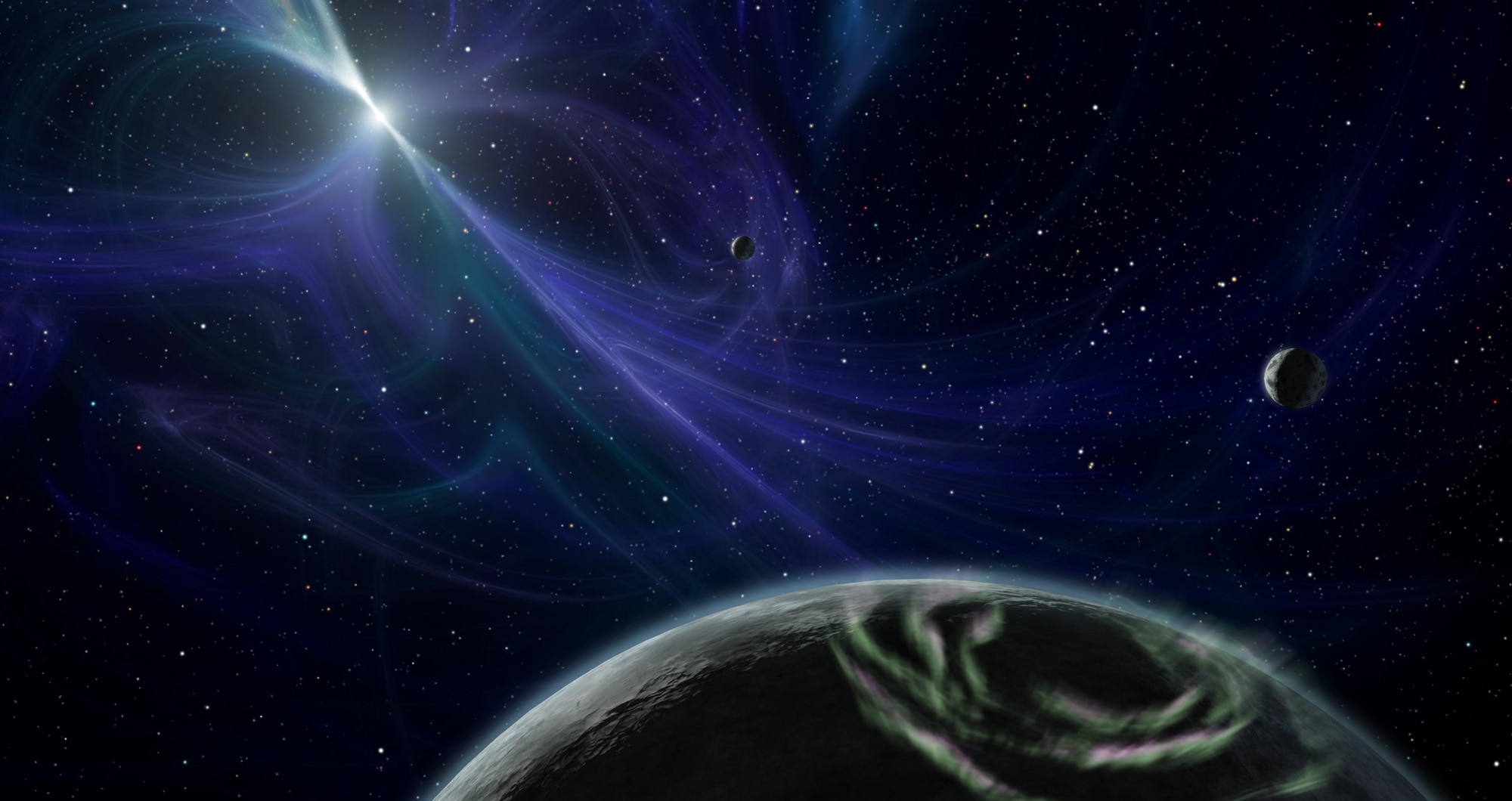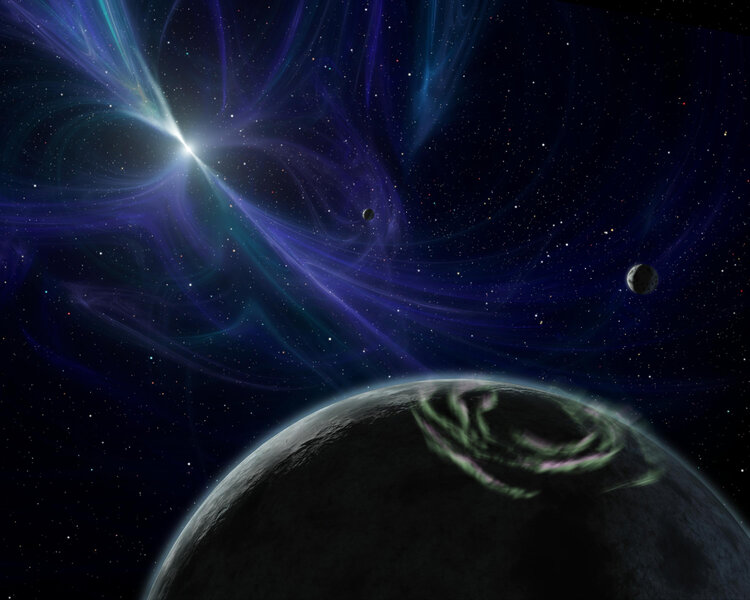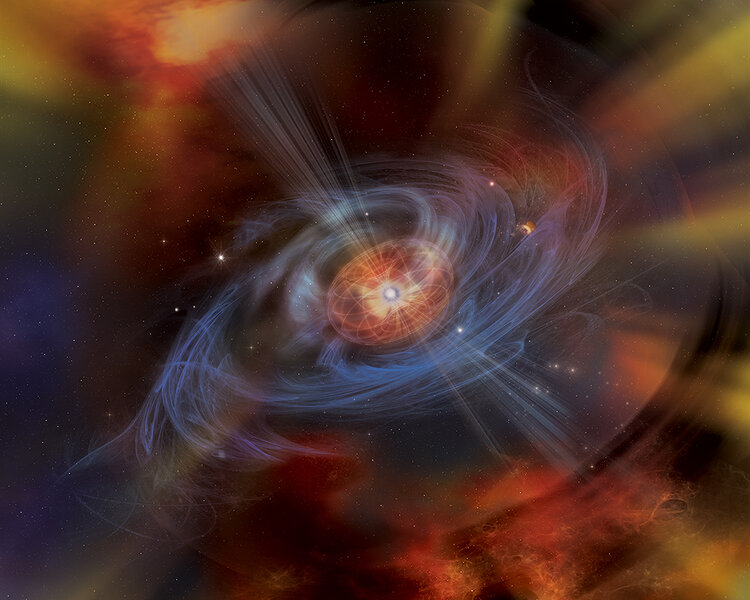Create a free profile to get unlimited access to exclusive videos, sweepstakes, and more!
Can life emerge after the fires of a supernova?

If there were one place in the Universe I'd guess life wouldn't be able to develop, it’s near a neutron star.
But then, I'm prejudiced. For good reason! Life on Earth has adapted pretty well to the conditions here. With abundant oxygen, water, and energy from a stable nearby star, we have it easy. It’s pretty comfy here.
But this attitude can make us complacent, lull us into thinking that conditions must be this way for life to arise, or that it at least needs a similar situation. But we have to be careful; now that we know that liquid water oceans may exist under the surfaces of moons in the outer solar system (and maybe even Pluto as well), we have to broaden our definition of "habitable."
The discovery of exoplanets, planets orbiting other stars, gave us a swift kick in the complacency as well. We've found that most of these planets are not at all like the Earth, and many aren't like anything we even have in our solar system. That's pretty cool, and a reminder that we need to keep our prejudices to a minimum when considering what kinds of environment might be clement.
But even then, I have a hard time imaging you could have life on a planet circling a pulsar, a rapidly spinning neutron star.
This is one of the most hostile objects in the Universe! Born in the heart of a supernova, a neutron star is the über-dense core of star that has the mass of the Sun but has collapsed down to be a mere few kilometers across. Its surface gravity can be a billion times the Earth's, and it's born hot, with a temperature of a million degrees.
And even all that isn't as lethal as the magnetic field of such a beast, which can be trillions or even quadrillions of times stronger than Earth's! A neutron star spins very rapidly after it's born, taking less than a second to rotate once; that frantic spin is coupled with the magnetic field, which whips around the star at high speed and creates intense radiation fields that are about as cozy as sitting next to the exposed core of a nuclear reactor.
So having planets around one at all is bizarre. But them being habitable? Come on.
Except, well, maybe. New research looking into how neutron stars emit energy shows this can actually work.
First of all, planets can exist around pulsars. In fact, the very first planets ever found outside our own solar system orbit a pulsar! There were discovered in 1992 around the pulsar PSR B1257+12. Most likely they formed after the supernova out of material left over from the explosion; there's lots of evidence that some of this stuff near the core of the star falls back to the center and forms a disk massive enough to make lots of planets.
PSR B1257 has three such planets: One that's very small (roughly twice the mass of our Moon) and two that are "super-Earths" with about four times the Earth's mass each. All three planets are pretty close to the neutron star; 29, 54, and 60 million kilometers out from it — the farthest isn't much farther out than Mercury is from the Sun.
Could they be temperate? Is that even possible?
What we're really asking is: Can a neutron star supply the right amount of energy to warm a planet orbiting it so that it neither freezes nor cooks? The answer to that is, yes. Kinda. But we have to be clear about what kind of energy we're talking about, and what effect it has on the planet.
The energy from a neutron stars comes in three forms: heat from its surface, X-rays from its surface, and high-speed subatomic particles whipped into a frenzy by its magnetic field.
The first isn't too hard to understand: If the neutron star is hot, it can heat up nearby planets. This is how the Sun heats us! The problem here, with respect to life, is that neutron stars are born ridiculously hot, then cool rapidly. They go from a million degrees down to thousands (like the surface of the Sun) in about a billion years. That actually is bad: Life might take a few hundred millions year to get its start on a planet, but then not too much later the heat source cools too much to sustain it. Life won't have much of a chance that way.
The second way a neutron star can warm a planet is via X-rays. An isolated neutron star moving through space plows through the thin soup of gas between the stars. The gravity of the neutron star is so fierce that it draws these in and they impact the surface at incredibly high speed, as much as 2/3rds the speed of light. This impact generates a lot of energy in the form of X-rays. There are other processes that can contribute to this as well, mostly involving the intense magnetic fields of the star.
The third way is by what's called a pulsar wind. If the star is still rotating rapidly, the magnetic field whips around the star as well. The details of the process are complex, but this can accelerate subatomic charged particles (electrons and protons) to very high speeds, which are then flung out like rocks from a sling.
Both the X-rays and the particle wind can transfer energy from the star to a planet nearby and warm it. The problem is balance.
X-rays, for example, are very high energy, and can break apart complex molecules … like, say, DNA. So too much of those is a real problem. The particle wind is bad too because if it's intense enough then, over time — in just a few thousand years for a planet like Earth — it can sandblast the planet, stripping away its atmosphere.
What the new research found is that a planet with an extremely thick atmosphere might fare well in such an environment. The X-rays can heat the outer portions, and that energy can be transferred down to the planet’s surface, and while the wind still does tend to erode away the air, the atmosphere is so thick that can take a long time. This provides some stability to the heating.
We don't know if the two larger planets around PSR B1257 have thick atmospheres, or even if they have any air at all. But astronomers found that for reasonable assumptions about the heating from the pulsar, they could have temperatures within the range of what we would call "habitable." But it's still a balancing act; they could still very easily be too hot or too cold as well. There's really no way to tell just yet; this work was more exploratory, a first shot at trying to figure this out. Unfortunately, they also found that even a thick atmosphere might erode away in a few hundred million years.
But don't despair! We know of about 3,000 neutron stars in our galaxy. Of these, only a handful are known to have planet-sized objects orbiting them. But there may be as many as a billion neutron stars in the Milky Way; if that ratio holds up then there could be tens of millions of neutron star planets out there in our galaxy alone!
Sure, the conditions we see for the planets we know about are — not to put too fine a point on it — sucky, but 10 million is a lot to choose from. Statistically speaking, it's possible we'll find some eventually that could support life. Of some sort, at least.
So, as with so many other things, we all need to get past our own prejudices and accept what the Universe is telling us. And it's saying that, hey, don't be so provincial! Just because things are the way they are for you doesn't mean it's that way for everyone, everywhere. Even near an X-ray-blasting radiation-swamped magnetically supercharged neutron star.




























